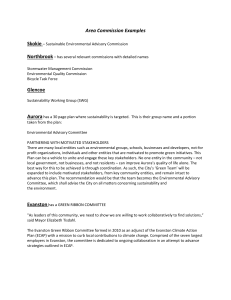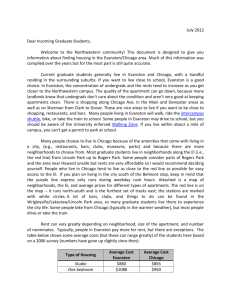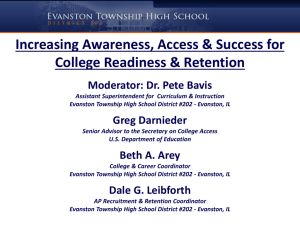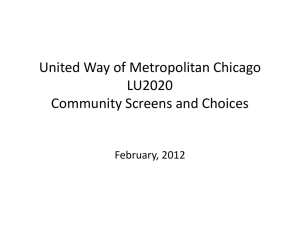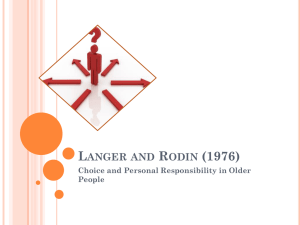EPLAN Survey - City of Evanston
advertisement
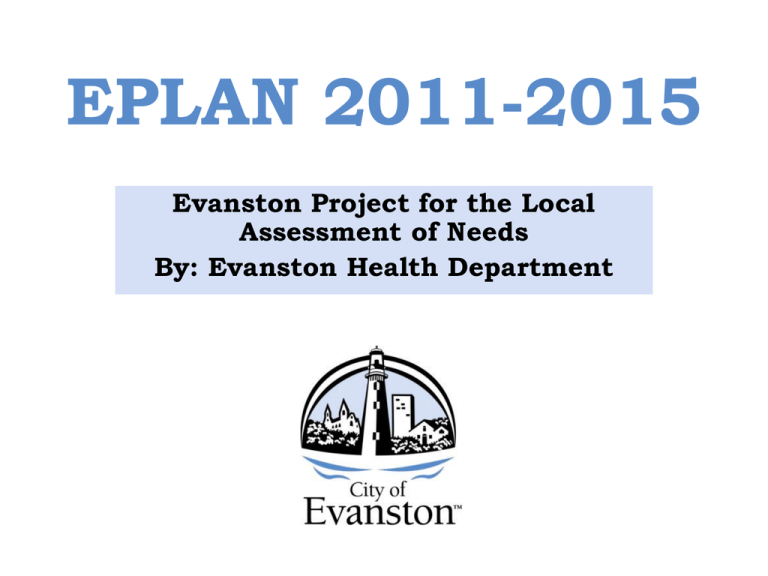
EPLAN 2011-2015 Evanston Project for the Local Assessment of Needs By: Evanston Health Department Moving Forward Background • EPLAN – Evanston’s version of the IPLAN • IPLAN – Conducted every 5 years by local health departments – Required for LHD certification – Based on Assessment Protocol for Excellence in Public Health (APEX-PH) Evanston Community Needs Assessment Survey • Conducted in December 2009 • Random sample of Evanston residents • Investigated perceived public health needs of those residents Evanston Community Needs Assessment Survey Results 1 Most Important Factors for a Healthy Community Easy access to affordable health care Low crime/safe neighborhoods 2 Good jobs and healthy economy 3 Most Important Health Problems in Our Community Obesity Substance abuse Most Important Risky Behaviors in Our Community Injury/violence prevention Being overweight Drug abuse Poor eating habits Evanston Community Needs Assessment Survey Results Health Programs needed in Evanston in order of importance: 1) Nutrition services and promotion of physical activity 2) Immunization services 3) Mental health services 4) Senior services 5) Emergency preparedness 6) Substance abuse prevention 7) Family planning services 8) Climate change initiatives 9) Adolescent health promotion 10) Smoking cessation programs EPLAN Survey • Conducted during September to December 2010 • Random sample of Evanston residents • Survey questions adopted from the BRFSS standardized surveys • Investigated health behaviors and beliefs of Evanston residents EPLAN Survey Results • Residents delayed seeking health care due to cost issues • High prevalence of hypertension • Low rates of heart attack and stroke awareness • High prevalence of smoking • High prevalence of alcohol consumption and binge-drinking patterns • Residents identified multiple reasons for not exercising regularly • Poor nutritional habits IL Department of Public Health Evanston Outside City Limits Diseases of the Heart 125 1 Malignant Neoplasms 111 4 Chronic Lower Respiratory Diseases 28 Cerebrovascular Diseases 24 Influenza and Pneumonia 22 Accidents 15 Diabetes Mellitus 12 Septicemia 11 Alzheimer’s Disease 10 Nephritis, Nephrotic Syndrome, and Nephrosis 7 Parkinson’s Disease 9 Intentional Self-harm (Suicide) 3 Essential Hypertension and Hypertensive Renal Disease 1 1 EHAC Survey Administration • Conducted in 2011 via email • For 21 council members • Investigated top three health priorities for Evanston – Access to health care – Chronic health conditions – Physical activity and nutrition Digging Deeper • Access to Health Care • Chronic Health Conditions • Nutrition and Physical Activity • Risk and Contributing Factors • Community Health Plan Objectives and Strategies Access to Health Care Risk and Contributing Factors Lack of/Inadequate Health Insurance 1) Unemployment – – 2) Lack of Health Care Resources Tailored to the Unique Needs of the Community 1) Job seekers lacking necessary skill set Non-availability of jobs – Socioeconomic status – – – – Lack of education (e.g. high school dropouts) Racial disparities Poverty Language and cultural barriers Disparities in access to health care – 2) Language and cultural barriers (esp. Hispanic populations) Knowledge barriers among low-income minority populations Increasing rates of teenage pregnancy – – Lack of specialized support groups and community health centers for teenagers Lower high school graduation rates among minorities Lack of Health Care Providers/Facilities for Underinsured and Uninsured 1) Designated medically underserved areas – 2) Closure of satellite clinics by Cook County Fewer providers accepting Medicaid/Public Aid – – Delayed reimbursement Low or no reimbursement Access to Health Care Community Plan Outcome Objectives By 2015, provide access to comprehensive health care services to lowincome families in Evanston US Census, 20052009 ACS Survey • Percentage of families below poverty level: 4.8% • Percentage of individuals below poverty level: 9.7% Impact Objectives By 2013, establish a Federally Qualified Health Center to provide primary health care and cater to needs of 5,516 unduplicated patients within 2 years of establishment Intervention Strategies • Opening a local satellite clinic will Improve access • Provision of umbrella services will reduce perceived barriers • Home-grown partnerships promote ownership of programs by the community Resources Available • Evanston Health Department • Erie Family Health Center • NorthShore University Health System • St. Francis Hospital • Local social service agencies Barriers and Challenges • Transportation • Perceived susceptibility • Perceived threat • Cues to action Chronic Health Conditions Risk and Contributing Factors Tobacco Use 1) Parent smoker – – 2) 1) Access to tobacco products Addictive nature – Access to tobacco products Media – – 2) – – Lack of anti-smoking ordinances Poor implementation of existing ordinances Work place/public smoking – 3) Perceived severity, perceived threat Perceived susceptibility Lack of free/mass screening efforts in the community – – – Excessive Alcohol Use 1) Lack of/inadequate health insurance Transportation costs Inherited costs (e.g. loss of pay) Personal choice – Secondhand smoking – Cost of screening – Peer pressure – 3) Lack of Primary Prevention Efforts Organizational costs Transportation costs Poor advertisement Access to alcohol – – 2) Parental tolerance Access to alcohol at home Poor implementation of law at points of sale Peer pressure – – – Adult role models who drink Glamorization by media Social acceptance Chronic Health Conditions Community Plan Outcome Objectives Impact Objectives By 2015, reduce the number of deaths caused by cardiovascular disease by 10% By March 2012, increase participation rate in Kick Butts Day by 10% 2006 IPLAN data for Evanston • Coronary heart disease mortality rates: Crude number – 92; Premature (<65) – 17 By March 2013, increase the number of residents who quit smoking by at least 10% Intervention Strategies • Reducing client out-of-pocket costs for smoking cessation therapies • Mass media campaigns when used with other interventions Resources Available • Evanston Health Department • NorthShore University Health System • St. Francis Hospital • YMCA • PEER Services • Northwestern University Barriers and Challenges • Addictive nature • Secondhand smoke exposure • Access to products Physical Activity and Nutrition Risk and Contributing Factors Physical Inactivity 1) Access to facilities – – – – – 2) Cost of working out Transportation Poor time management Bad weather conditions Availability of parks, walking paths, and bike routes Poor Nutrition 1) – – – – 2) – Lack of awareness Low perceived risk Television viewing, video gaming, and computers Inconsistent efforts 3) Media Ease of access Distorted portion control Lifestyle/convenience Addictive nature of junk food – – – Behavioral choices – – – Abundance of fast food and junk food High fat content Food additives Perceptions regarding comfort food Availability of nutritious food – – – Cost of fruits and vegetables Distribution of supermarkets Seasonal availability Physical Activity and Nutrition Community Plan Outcome Objectives By 2015, reduce the number of adults who do not get any exercise by 10% BRFSS 2009 Suburban Cook County Percentage of residents who currently do not get any exercise: 24% Impact Objectives By 2012, increase the number of participants in Women Out Walking program by 10% Intervention Strategies • Community-wide campaigns • Social support interventions to community settings Resources Available • Evanston Health Department • City of Evanston • Northwestern University • Evanston Chamber of Commerce • Evanston 150 • Rotary International • Evanston Public Library Barriers and Challenges • Bad weather • Poor time management • Cost of gym memberships Acknowledgements • Evanston Health Department Staff – • Evanston Health Advisory Council – • – – – – John Alexander, MD, Acting Executive Director and Medical Director of Northwestern University Health Services Evanston Campus Dr. Kalyan Nadiminti, St. Francis Hospital Dianne Rucinski, Ph.D, Health Evaluation Collaborative & Institute for Health Research and Policy Rebecca Wurtz, MD, MPH, Director of the MPH Program at Northwestern University Felicia Morgan, Salvation Army Social Services Northwestern University Volunteers – • George S. Rudis, MA, CPHA Community Members – • Karen Chavers; Mary Daley; Natasha Deutsch; Kim Fisher; Avery Hart, MD; Delores Holmes; Dr. Edward Hughes; Mary Larson, CSN; Louis Rowitz, PhD; Bonnie Lockhart, RN; Angelique Richard, PhD, RN; Paul Luning, MD, MPH; Woody McCally; Julianne Russell; Mark Schroeder; Marybeth Schroeder; C. Louise Brown; Donald W. Zeiglar, PhD; Judith Simon; Tanille Baaske Smith; Jennifer Vyenielo IL Department of Public Health – • Bruce Doblin, MD; Carl Caneva; Jonathan Webb; Sree Pilla; Dr. Avinash Pasam; Diane Keenan; Sandra Waggoner; Robyn Nisi Lauren Slubowski; Sana Ali; Sarah Basore; Sophia Blachman-Biatch; Laura Booth; Chelsea Cooper; Lauren Dawson; Blake Erickson; Allison Finn; Jennifer Hemesath; Jenna Kastan; Ummul-Kiram Kathawalla; Lindsey Kreutzer; Allison Lazarus; Joanne Maliekel; Anna Messier; Marielle Meurice; Kathryn Nathanson; Christopher Oh; Sojung Park; Lakshmi Ramachandran; Alexandra Rivkin; Emily Roskey; Jay Shiao; Ritika Singh; Meera Sriram; Matthew Stephens; Leah Thomas; Sandeep Tummala; Katherine Wang; Alexandra Wong; Teisha Lightbourne; Jessice Gottesman; Katie Raynolds; Swen Hendrickson; Ben Diapola Kellie Perkins, Health Director Intern – – (757) 329-4005 kdperkins89@yahoo.com Thank You Are there any questions?
